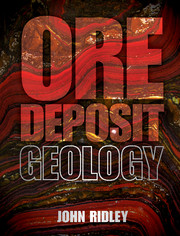Book contents
- Frontmatter
- Contents
- List of boxes
- Preface
- Acknowledgements
- 1 What is an ore deposit?
- 2 Magmatic ore deposits
- 3 Hydrothermal ore deposits I: magmatic and orogenic environments
- 4 Hydrothermal ore deposits II: sedimentary environments
- 5 Ore deposits formed in sedimentary environments
- 6 Supergene ores and supergene overprinting of ores
- Glossary
- References
- Index
- References
1 - What is an ore deposit?
- Frontmatter
- Contents
- List of boxes
- Preface
- Acknowledgements
- 1 What is an ore deposit?
- 2 Magmatic ore deposits
- 3 Hydrothermal ore deposits I: magmatic and orogenic environments
- 4 Hydrothermal ore deposits II: sedimentary environments
- 5 Ore deposits formed in sedimentary environments
- 6 Supergene ores and supergene overprinting of ores
- Glossary
- References
- Index
- References
Summary
Definition and scope of ore deposit geology
We extract many types of commodities from the Earth; minerals and rocks from mines, hydrocarbon liquids and gases and groundwater through pumping or where they rise to the surface under their own pressure, the heat of rocks as geothermal energy. An ore deposit is ‘what is mined’. Precise definitions of the term are based on economics rather than geology, for instance:
ore is rock that may be, is hoped to be, will be, is or has been mined; and from which something of value may be (or has been) extracted.
(Taylor, 1989, Ore reserves – a general overview. Mining Industry International, vol. 990, pp. 5–12.)Which commodities are included by the definition of ore deposits?
The economic definition of an ore deposit given above would include:
ores of metals
ores of gemstones
ores of minerals used as feedstock for production of industrial chemicals
ores of minerals used in industrial products
rock used as aggregate, for building stone
coal and oil shale
This book does not cover all mined commodities. Traditionally, the study of ore deposit geology has been concerned with mineral resources in which the product of economic interest is one or more mineral, specifically either those minerals from which a metal is extracted or gemstones. A practising ore deposit geologist may be expected to have knowledge of sources of these commodities. The study does not include either the mining of rocks or of coal. Nor does it generally include the mining of minerals that are used exclusively as feedstock in industrial processing or products (industrial minerals).
- Type
- Chapter
- Information
- Ore Deposit Geology , pp. 1 - 21Publisher: Cambridge University PressPrint publication year: 2013



